Eurocopter AS365 Dauphin
| SA 365 Dauphin 2 AS365 Dauphin | |
|---|---|
.jpg) | |
| A British Army Air Corps Dauphin 2 landing at Glasgow Airport, Scotland | |
| Role | transport/utility helicopter |
| National origin | France |
| Manufacturer | Aérospatiale Eurocopter Airbus Helicopters |
| First flight | 24 January 1975 |
| Introduction | December 1978 |
| Status | In service |
| Primary users | Pawan Hans Maryland State Police |
| Produced | 1975–present |
| Number built | 1,000+[1] |
| Unit cost |
<US$10M, €7.5M |
| Developed from | Aérospatiale SA 360 |
| Variants | Eurocopter HH-65 Dolphin Eurocopter AS565 Panther Harbin Z-9 |
| Developed into | Eurocopter EC 155 |
The Airbus Helicopters AS365 Dauphin (Dolphin), formerly known as the Aérospatiale SA 365 Dauphin 2 and the Eurocopter AS365 Dauphin, is a medium-weight multipurpose twin-engine helicopter currently produced by Airbus Helicopters. It was originally developed and manufactured by French firm Aérospatiale, which was merged into the multinational Eurocopter company during the 1990s. Since entering production in 1975, the type has been in continuous production for more than 40 years. The intended successor to the Dauphin is the Airbus Helicopters H160, which is yet to enter operational service as of March 2015.[2]
The Dauphin 2 shares many similarities with the Aérospatiale SA 360, a commercially unsuccessful single-engine helicopter; however the twin-engine Dauphin 2 did meet with customer demands and has been operated by a wide variety of civil and military operators. Since the type's introduction in the 1970s, several major variations and specialised versions of the Dauphin 2 have been developed and entered production, including the military-oriented Eurocopter Panther, the air-sea rescue HH/MH-65 Dolphin, the Chinese-manufactured Harbin Z-9 and the modernised Eurocopter EC155.
Development
The SA 365/AS365 Dauphin 2 is a twin-engine development of the commercially unsuccessful single-engined Aérospatiale SA 360 Dauphin; only a year after the SA 360's entry into service, Aerospatiale had recognized that a platform powered by two engines rather than one was better suited to both civil and military operations, thus a redesign program was initiated.[3][4] In January 1975, the first twin-engine Dauphin prototype performed its first flight; the prototype soon demonstrated an airspeed of 170 knots in level flight and set multiple speed records.[4] Deliveries of production models began later that decade.[3]

The initial production variant entered service under the original designation of SA 365C; French certification of this model was received in July 1978.[4] In 1982, the SA 356C Dauphin was succeeded by the more capable SA 365 N. Amongst several major design changes and improvements, the SA 365 N featured more powerful engines, greater use of composite materials, a better cabin arrangement, and retractable landing gear.[3][5]
Further improvements were made with the introduction of the SA 365 N1, which had a substantially redesigned Fenestron anti-torque device, and with the SA 365 N2, which was equipped with more powerful Turbomeca Arriel 1C2 turboshaft engines.[5] In January 1990, the overall type was formally redesignated as the AS365. The AS365 Dauphin is one of Eurocopter's more successful helicopter designs; and has been widely used as a corporate transport, airborne law enforcement platform, emergency medical services (EMS) helicopter, electronic news gathering platform, and search & rescue helicopter.
The base Dauphin has been further developed into several purpose-built variants. During the 1980s, the SA 365 N was used as the basis for a militarised version of the Dauphin, initially designed as AS 365 K, which was used to perform utility, troop-transport, and maritime operations, widely known as the Eurocopter Panther.[6] A variant of the Dauphin was specifically developed for and operated principally by the United States Coast Guard under the designation HH/MH-65 Dolphin. The SA 365 M model of the Dauphin has also been manufactured under licence in China as the Z-9 by the Harbin Aircraft Manufacturing Corporation; the Z-9 was subsequently developed into the armed WZ-9 and Z-19 attack helicopter.[6]
Design
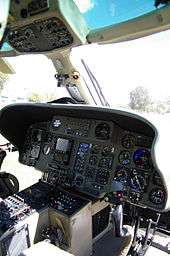
The AS365 Dauphin is a twin-engine helicopter capable of travelling long ranges, and well suited to operating in climates of a high ambient temperature or at locations of significant altitude. The Dauphin is typically powered by a pair of Turbomeca Arriel turboshaft engines; on later variants, these are equipped with FADEC units, which provide additional functionality such as an automated start-up sequence and a training mode.[7] The engines drive the rotorcraft's foldable Starflex main rotor which and its Fenestron anti-torque tail rotor via two separate transmissions; these gearboxes are also connected to two separate hydraulic systems as well as a stand-by hydraulic system for emergency use, such as deployment of the landing gear.[7] Electrical power is provided by a pair of starter generators and a cadmium-nickel main battery, an emergency battery is also present.[7]
The main fuselage of the rotorcraft comprises the cabin area, a separate luggage compartment, and a retractable tricycle landing gear arrangement; a total of four conventional doors to access the main cabin are typically installed, which can be optionally replaced by a single clamshell air stair entrance instead.[8] Various portions of the rotorcraft are made from composite materials, such as the rotor blades that made of carbon fiber, other materials are used in portions of the fuselage.[7] The fuselage features anti-corrosion protection, and is structurally reinforced for an optional hoist or cargo sling to be installed, various other mooring and gripping points are also fitted on the rotocraft's exterior surface.[7] Various types and models of radar can be installed in the Dauphin's nose.[7]
The combination of the rotorcraft's Starflex main rotor and Fenestron tail provides a low-noise and low-vibration flight experience for those on board; Airbus Helicopters has claimed the sound emissions of the AS365 N3 to be 3.1 decibels below International Civil Aviation Organisation (ICAO) standards, making it the quietest helicopter in its class.[7][9] The Dauphin can take off under a full load from sea level under Category A conditions.[9] The main cabin area is designed to be reconfigurable, a feature which is promoted to emergency medical service (EMS) and search and rescue (SAR) operators. In a regular passenger transport layout, the cabin can accommodate up to 12 passengers in addition to the two pilots; up to seven passengers can be accommodated in a VIP layout.[9] Access to the cabin is via large sliding doors on either side of the helicopter, built-in boarding steps are typically installed to ease the boarding of passengers.[10]
While the cockpit is typically equipped with dual flight controls for two-man operations, the Dauphin can be readily flown by a single pilot while operating under instrument flight rules; this was achieved in part by avionics such as the 4-axis Dual Digital Automatic Flight Control System (older production aircraft use a 3-axis flight control system with integrated autopilot instead[11]) to reduce crew workload.[12] The principle flight control system are connected to a total of 3 dual-chamber primary servo-units for cyclical and collective pitch control, and a single dual-chamber rear servo-unit for tail rotor pitch control.[7] Other major avionics include 10.4-inch multi-mission touch screen displays, weather radar, global positioning system (GPS) receiver, traffic alert and collision avoidance system (TCAS), automatic voice alarm device (AVAD), health and usage monitoring system (HUMS), quick access records for helicopter flight data management, and digital audio communication system (DACS).[9]
Operational history
.jpg)
In February 1980, the first series production Dauphin was used to break three separate speed-related world records in separate journeys between Battersea, London, United Kingdom and Issy-les-Moulineaux, Paris, France.[13] In 1985, a new model of the Dauphin, the AS365 F, became the first rotorcraft in the world to fly with flight instruments being displayed in electronic displays, which replaced the traditional instrumentation; this variant was first procured by the Irish Air Corps for SAR operations.[13]
The French Navy operated the Dauphin, in addition to the dedicated military-orientated Panther variant, to conduct various missions such as the Dauphin Service Public which involves various duties from seaborne SAR, maritime monitoring, and responding to distress calls.[14][15] French Navy Dauphins are commonly deployed on board the aircraft carrier Charles de Gaulle as well as onboard other vessels of the French Navy and allies;[16][17] they are fitted with a haul-down Harpoon in order to ease shipboard landings in rough weather.[18]
In November 2011, the French Navy began operational use of a newer model of the Dauphin, the Dauphin N3+, as a replacement for aging Eurocopter AS332 Super Pumas stationed in French Polynesia;[19][20] the primary missions being SAR and MEDIVAC duties in this region.[20]
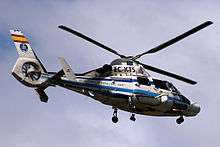
By 1980, a total of 265 AS360/361/365 Dauphins had been delivered, 88% of these deliveries were to foreign customers in a total of 23 different nations.[21] Amongst the biggest early customers for the type was Saudi Arabia, which ordered 24 Dauphins, and Angola, with an order for 17 Dauphins.[22] The largest civil customers of the type has been Indian operator Pawan Hans, who by 2003 had a fleet of 19 Dauphins (nearly two-thirds of their total rotary fleet) and were in the process of procuring another 11 Dauphins to allow older aircraft to be phased out; they have been frequently used to support offshore oil extraction activities.[23][24]
In February 1991, it was announced that the 500th Dauphin had been delivered to Bond Helicopters, who at that time operated a total of 15 of the type, with additional Dauphins on order. By 1991, the Dauphin was being operated by 138 customers across 44 nations.[25] In December 2006, Eurocopter president Fabrice Brégier stated that between 30 and 40 Dauphins were being delivered each year.[26] By 2011, more than 1,000 AS365/366/565 versions had been produced; Pawan Hans took delivery of the 1,000th Dauphin produced in April 2011, at which point the type was reportedly in service with over 300 operators worldwide.[1][27]
Prior to the 2004 Summer Olympics, five AS 356N3 Dauphins were procured for the Hellenic Coast Guard for harbor surveillance purposes.[28] Between 2009 and 2012, the Army Air Corps of the United Kingdom took delivery of five Dauphins, these were assigned to No. 658 Squadron AAC to replace four AgustaWestland A109 helicopters being used to support Special Air Service (SAS) operations.[29]
As of 2014, the AS365 N variant of the Dauphin holds the world speed record for a 3-kilometre (1.9 mi) course, set at 372 km/h (231 mph) in 1991.[30]
Variants
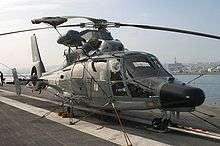
Civil variants
- SA 365 C
- A twin-engined version of the Dauphin, designated as the Dauphin 2, was announced in early 1973. The first prototype's first flight took place on 24 January 1975; production model deliveries began in December 1978. In comparison with the earlier model, the SA 365 C featured twin 470 kW (630 shp) Arriel 1 turboshafts in a new engine fairing, a Starflex main rotor hub and a higher maximum take-off weight (3,400 kg (7,496 lb) or 7,495 lb). Its Fenestron anti-torque device featured 13 metal blades. Production of both the SA 360 and SA 365 C ceased in 1981, by which time approximately 40 SA 360s and 50 SA 365 C/C1s had been built; both were replaced by the SA 365 N.
- SA 365 C1
- Variant powered by Arriel 1A1 certified in March 1979.[31]
- SA 365 C2
- Variant powered by Arriel 1A2 certified in February 1980.[31]
- SA 365 C3
- Variant powered by Arriel 1C certified in January 1982.[31]
- SA 365 N
- A much improved version of the SA 365 C Dauphin 2, the first prototype flying on 31 March 1979. This version introduced the uprated 492 kW (660 shp) Arriel 1C turboshafts, a retractable tricycle undercarriage, enlarged tail surfaces, and revised transmission, main rotor, rotor mast fairing and engine cowlings. The aircraft's initial M.T.O.W. of 3,850 kg (8,490 lb) was later raised to 4,000 kg (8,800 lb). Deliveries of the production model began in 1982.
- SA 365 N1
- Incorporating many of the improvements developed for the SA 366 G1 (HH-65 Dolphin), this version introduced upgraded 526 kW (705 shp) Arriel 1C1 turboshafts, an improved 11-blade Fenestron with wider-cord blades (which reduced the AS365 N1's noise signature), movable undercarriage doors replaced by simplified fairings and a higher gross weight of 4,100 kg (9,000 lb).
- AS 365 N2
- This version – designated AS365 N2 from the outset – introduced the upgraded 549 kW (737 shp) Arriel 1C2 turboshafts, an uprated gearbox, increased maximum take-off weight of 4,250 kg (9,370 lb), redesigned cabin doors and revised interior, enlarged tail fin with all composite Fenestron. Deliveries of this version started in 1990. Licensed versions were assembled in China as the Z-9 and Z-9A and built in Brazil by Helibras.
- AS365 N3
- The high-performance AS365 N3 was developed for operations in 'hot and high' climates, and introduced 635 kW (851 shp) Arriel 2C turboshafts equipped with a single channel DECU (Digital Engine Control Unit) with manual reversion, mated to an uprated main transmission for better single engine performance. The AS365 N3 also features a redesigned ten blade composite Fenestron anti-torque device with asymmetric blade distribution, offering a further reduction in noise signature. The AS365 N3's gross weight is 4,300 kg (9,500 lb). Production deliveries began in December 1998 and this version is currently still in production. Also manufactured in Brazil by Helibras.
- AS365 N4
- Produced as the EC155.
- AS365 X
- Better known as the DGV 200 or Dauphin Grand Vitesse (High Speed Dauphin), the AS365 X was developed from the X-380 DTP (Developpement Technique Probatoire or Probatory Technical Development) testbed, first flown on 20 March 1989.[32] The aircraft was first flown in the AS365 X configuration two years later in March 1991, and featured a smaller Fenestron, a new main rotor with five high-inertia blades with swept tips, a composite rotor hub/mast and 624 kW (837 shp) Turbomeca Arriel IX turboshafts. On 19 November 1991, this aircraft set a Class E1e (3,000 to 4,500 kg) speed record of 201 knots (372 km/h; 231 mph) over a 3 km (1.9 mi) triangular course.[13]
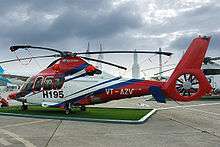
- EC155 B/B1
- This version was originally to follow the N3 as the AS365 N4, and was announced at the 1997 Paris Airshow before being redesignated as the EC155 B. As with the N3 version, it has two Arriel 2C/2C2 turboshafts equipped with FADEC as well as a five blade Spheriflex main rotor (derived from the AS365 X DGV). It also features a 30% larger main cabin (achieved with bulged doors and cabin plugs). The first flight of the first prototype took place on 17 June 1997 and this version is currently in production (as the EC155 B1).
Military variants
- AS565 Panther
- SA 366 G1 Dauphin
- The SA 366 G1 Dauphin version was selected by the US Coast Guard (USCG) in 1979 as its new air-sea rescue helicopter and given the designation HH-65A Dolphin.[3] In total 99 helicopters, optimised for the USCG's short-range recovery (SRR) search and rescue role, were initially acquired, with additional aircraft later procured.
Operators
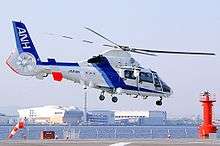
The Dauphin is flown by a range of private operators, companies, emergency services, government agencies and air charter companies.
Government operators
- National Airborne Service Corps[36]
- Republic of China Coast Guard - uses AS365 N2 variant

Military operators
Former operators
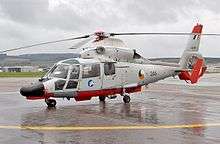
Aircraft on display
- SA365N Dauphin, F-WQAP, at The Helicopter Museum, Weston-super-Mare, United Kingdom.[57]
Accidents and notable incidents
On 4 April 2015, an AS365 owned by Orion Corridor Sdn Bhd, crashed in Semenyih near Kajang, Malaysia. All six people on board, including the ex-ambassador of Malaysia to the US and Rompin MP, Tan Sri Jamaluddin Jarjis, and the Private Secretary to the Prime Minister, Datuk Azlin Alias, were killed. The helicopter was coming from a wedding party of the Malaysian Prime Minister's daughter.[58][59]
Specifications (AS365 N3)
|
| |
|
| |
|
|
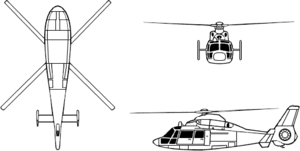
Data from {Eurocopter.com}[60]
General characteristics
- Crew: 1 or 2 pilots
- Capacity: 11 or 12 passengers
- Length: 13.73 m (45 ft 1 in)
- Height: 4.06 m (13 ft 4 in)
- Empty weight: 2,411 kg (5,315 lb)
- Max takeoff weight: 4,300 kg (9,480 lb)
- Powerplant: 2 × Turboméca Arriel 2C turboshaft, Take-off Power, 625 kW (838 hp) each
- Main rotor diameter: 11.94 m (39 ft 2 in)
- Main rotor area: 111.98 m2 (1,205.3 sq ft)
Performance
- Maximum speed: 306 km/h (190 mph; 165 kn)
- Ferry range: 827 km (514 mi; 447 nmi)
- Service ceiling: 5,865 m (19,242 ft)
- Rate of climb: 8.9 m/s (1,750 ft/min)
See also
- Related development
- Aérospatiale SA 360
- HH-65 Dolphin
- Eurocopter Panther
- Eurocopter EC 155
- Harbin Z-9
- Airbus Helicopters H160
- Aircraft of comparable role, configuration and era
- Related lists
References
Citations
- 1 2 Dubois, Thierry. "Rotorcraft Update: Eurocopter Delivers 1,000th Dauphin." AIN Online, 23 May 2011.
- ↑ Perry, Dominic. "Airbus Helicopters targets AW139 with new H160" Flight International, 3 March 2015.
- 1 2 3 4 Chant 2014, p. 353.
- 1 2 3 McGowen 2005, p. 125.
- 1 2 McClellan 1989, p. 77.
- 1 2 McGowen 2005, p. 163.
- 1 2 3 4 5 6 7 8 "AS365 N3+ Technical Data 2015." Airbus Helicopters, Retrieved: 22 November 2015.
- ↑ McClellan 1989, p. 80.
- 1 2 3 4 "AS365 N3+." Airbus Helicopters, Retrieved: 22 November 2015.
- ↑ "Private Aircraft – Eurocopter AS365 Dauphin." Air Charter Service, Retrieved: 12 April 2015.
- ↑ McClellan 1989, p. 78.
- ↑ "Eurocopter AS365 Dauphin." Analar Corporation, Retrieved: 12 April 15.
- 1 2 3 "1972: SA360/ AS365 Dauphin - AS565 Panther- EC155." Eurocopter, Retrieved: 8 December 2015.
- ↑ "Dauphin." Marine Nationale, 20 January 2015.
- ↑ "L'hélicoptère Dauphin de service public de la Marine nationale effectue une evacuation médicale sur le ferry Pascal Paoli." premar-mediterranee.gouv.fr, 19 October 2015.
- ↑ "MEDITERRANEAN SEA - French navy AS365 F Dauphin rescue helicopter from the French aircraft carrier Charles de Gaulle (R91) test lands aboard USS Mount Whitney (LCC/JCC 20." EUCOM, 21 March 2011.
- ↑ Malek, Caline. "French aircraft carrier Charles de Gaulle arrives in Abu Dhabi." The National, 8 January 2014.
- ↑ "Defence." Flight International, 8 October 1983. p. 937.
- ↑ Osborne, Tony. "French Navy unit begins operational use of Dauphin N3+." Shepard Media, 21 November 2011.
- 1 2 "The first Dauphin AS365 N3+ SAR Shines In French Polynesia." Rotor, June 2012.
- ↑ Kolodziej 2014, p. 98.
- ↑ Kolodziej 2014, pp. 180.
- ↑ "Dauphins for Pawan Hans." Flight International, 3 March 2003.
- ↑ "Dauphin and EC135: One Thousand And Counting." Rotor, December 2011. p. 14.
- ↑ "Business Briefs." Flying Magazine, February 1991. Vol. 118, No. 2. ISSN 0015-4806. p. 26.
- ↑ Apter, Jeff. "Heli-Union takes the 800th EC Dauphin ." AIN Online, 13 December 2006.
- ↑ Tim Ripley (10 December 2008). "UK Army Air Corps received Dauphins". Jane's Defence Weekly. 45 (50): 10.
- ↑ "Contracts." Flight International, 38 April 2003. p. 18.
- ↑ "UK special forces add fifth N3 Dauphin." helihub.com, 13 January 2012.
- ↑ "FAI Record ID #11658 – Speed over a 3 km course. Class E-Rotorcraft (Absolute Record of class E) " Fédération Aéronautique Internationale (FAI). Retrieved: 21 September 2014. Others: 2084, 2085
- 1 2 3 EASA Type Certificate Data Sheet R105
- ↑ Sedbon, Gilbert. "Aerospatiale flies faster Dauphin." Flight International, 20 May 1989.
- ↑ "Victorian Police". Archived from the original on 9 April 2013. Retrieved 6 April 2013.
- ↑ "Western Australia Police". Retrieved 19 July 2013.
- ↑ "Argentine Coast Guard". Retrieved 3 January 2013.
- ↑ "National Airborne Service Corps (NASC)". Copyright 2007 TaiwanAirPower. Retrieved 28 December 2012.
- ↑ "Sécurité Civile". Copyright 2005–2012 Helico-Fascination. Retrieved 20 December 2012.
- ↑ "Hellenic Air Force Open Day 2004, Elefsina-Tatoi". Copyright 2002-3 by ACIG.org. Retrieved 28 December 2012.
- ↑ "Icelandic Coast Guard". www.helis.com. Retrieved 28 December 2012.
- ↑ "Kuwait Police engineering contract". Helihub.com. 29 September 2011. Retrieved 6 December 2012.
- ↑ "Malaysian Maritime Enforcement Agency". Retrieved 3 January 2013.
- ↑ Yanez, Roberto (October 2016). "Airscene: In Numbers: Guardia Civil AS365N3". Air International. Vol. 91 no. 4. p. 33. ISSN 0306-5634.
- ↑ "Servicio de vigilancia aduanera".
- 1 2 3 4 5 6 "World Air Forces 2014" (PDF). Flightglobal Insight. 2014. Retrieved 15 February 2014.
- ↑ "Aerospatiale-AS-365N-2-Dauphin". Demand Media, Inc. 2012. Retrieved 6 December 2012.
- ↑ "Djibouti Air Force gets two Y-12s; Dauphin helicopters". defenceWeb. 2016. Retrieved 19 July 2016.
- ↑ "Lithuania Orders Eurocopter Dauphin Helos". www.defensenews.com. 28 October 2013. Retrieved 29 October 2013.
- ↑ "The Lithuanian Air Force orders three Eurocopter AS365 N3 Dauphin helicopters". 28 October 2013.
- ↑ AirForces Monthly. Stamford, Lincolnshire, England: Key Publishing Ltd. August 2016. p. 30.
- ↑ "Pictaero". 2007–2012 AGAW. Retrieved 6 December 2012.
- ↑ Hoyle Flight International 11–17 December 2012, p. 62.
- ↑ "Aerospatiale-AS-365N-2-Dauphin". Demand Media, Inc. 2012. Retrieved 6 December 2012.
- ↑ Beech, Eric (30 July 1988). "The Irish Identity". Flight International. Vol. 134 no. 4124. pp. 19–23.
- ↑ Hoyle, Craig (15 May 2009). "Irish Air Corps adds helicopters to inventory". Flightglobal. Retrieved 22 December 2012.
- ↑ "World Air Forces 1996 pg. 53". flightglobal.com. Retrieved 1 January 2015.
- ↑ "SLAF History". Sri Lanka Air Force Command Media Unit. Retrieved 26 December 2012.
- ↑ "The Helicopter Museum: Western European Helicopters." helicoptermuseum.co.uk, .
- ↑ "Chopper crash: MP Jamaluddin Jarjis among six on board". The Star. 4 April 2015.
- ↑ "Helicopter Crashes in Semenyih". Bernama. 5 April 2015.
- ↑ "Eurocopter AS365 N3 Technical Data" (PDF). Archived from the original (PDF) on 10 November 2006. Retrieved 10 March 2007.
Bibliography
- Hoyle, Craig (11–17 December 2012). "World Air Forces Directory". Flight International. Vol. 182 no. 5370. pp. 40–64. ISSN 0015-3710.
- Chant, Chris. "A Compendium of Armaments and Military Hardware." Routledge, 2014. ISBN 1-13464-668-2.
- J. Mac, McClellan. Day of the Dauphin. From France to you: Aerospatiale's Dauphine is the Prince of Helicopter. Flying Magazine, September 1989. Vol. 116, No. 9. ISSN 0015-4806. pp. 76–80.
- McGowen, Stanley S. "Helicopters: An Illustrated History of Their Impact." ABC-CLIO, 2005. ISBN 1-85109-468-7.
- Kolodziej, Edward A. "Making and Marketing Arms: The French Experience and Its Implications for the International System." Princeton University Press, 2014. ISBN 1-40085-877-1.
External links
| Wikimedia Commons has media related to Airbus Helicopters AS365 Dauphin. |
